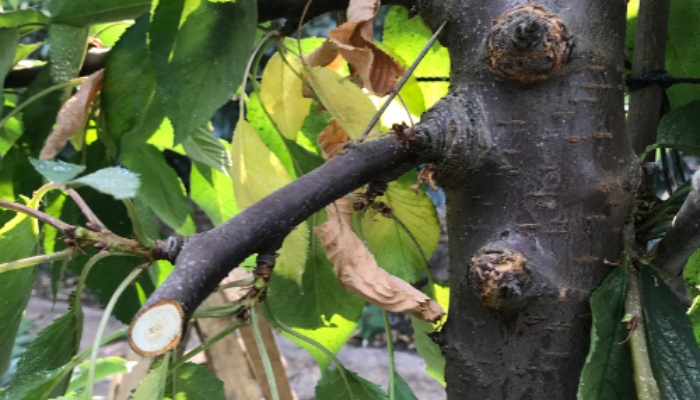
Pruning is not only a fundamental task for the maintenance, renewal and management of a cherry orchard, but it is also a strategy that, used correctly, allows it to achieve its maximum productive potential. Of course, there are different types of pruning and their techniques and times may vary, depending on the final objective.
Types of pruning and its objectives
1. Thinning cuts
This is usually made during the dormant time, and consists of pruning branches that are “hanging”, weak or too small in thickness, which allows you to eliminate or renew those branches that bear fruit that are too small .
At the same time, pruning removes dead, diseased, or damaged branches, preventing the spread of diseases and improving the tree’s overall health. This is our first fruit load regulation tool, leaving the number of target darts for the projected kilograms. In the case of newly planted fruit trees, this technique is crucial for shaping the tree’s structure and establishing a strong framework for future growth.
2. Stub cuts
This pruning is carried out with the aim of reducing the current crop and renewing spurs. It is recommended to do it during the rest season (every year from the second season of significant production), and consists of the renewal of branches around 10% of them (even though, there is not an specific correct number), which allows young spurs and the production of better fruit quality. In addition, proper pruning helps open up the canopy, allowing better air circulation and sunlight penetration.
3. Thinning cuts for sunlight
One of the main reasons for pruning is to encourage and enhance high quality fruit, by giving the tree more sunlight exposure. Fruit trees require sufficient sun to produce sugars through photosynthesis, which contributes to fruit flavor and quality. Light is also a key factor in flower bud induction and the differentiation process.
Pruning during the summer season each year allows sunlight to penetrate to the center, increasing photosynthesis and giving way to fruit growth throughout the tree.
The way to do this technique is to thin out the new shoots on a single branch, especially at the top of the tree.
4. Heading cuts
Trimming all the new branches, which will produce fruit later, leaving a third or half of each one, allows the stimulation of branching and the appearance of new leaves. In addition, reduces future crop load by eliminating the buds that are closest together and will have the most flowers per spur.
Thinning excess fruit is necessary to avoid overcrowding, which can lead to smaller, lower-quality fruit. Controlling size and shape will also give you control of the size and shape of the fruit tree, making it easier to manage, harvest, and maintain. This is generally done post-harvest before entering dormancy, where any type of pruning will be debilitating. On special occasions it can be done in October/April (southern or northern hemisphere, respectively) or in winter.
Finally, it must be clear that to carry out any type of pruning it is necessary to have an orchard in good condition from a phytosanitary point of view, with its programs up to date, which will allow the objectives of each technique to be met and what We wait for our cherry harvest.











